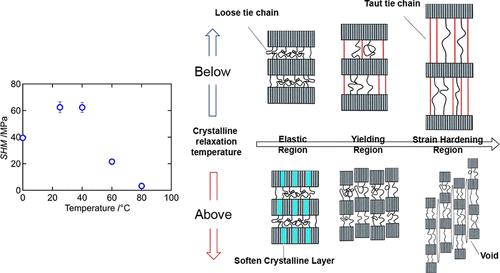用SAXS, WAXD和拉曼光谱评价聚乙烯固体应变硬化行为的温度依赖性
IF 5.2
1区 化学
Q1 POLYMER SCIENCE
引用次数: 0
摘要
在单轴拉伸试验中,我们利用拉曼光谱和小角和广角x射线散射研究了温度对应变硬化行为的影响。为了准确测量应变硬化,准备了拉伸到应变硬化区开始的预拉伸试样。应变硬化模量的温度依赖性在晶体松弛温度(~ 50℃)处达到最大值。低温拉伸时,由于施加在晶体链上的强拉伸载荷使晶体结构无序。此外,拉曼光谱揭示了大量高负载分子链的形成,我们将其归因于紧系链。而高温拉伸时,晶体结构在应变硬化区较为稳定,且拉伸载荷对结晶链的作用比低温拉伸时更为均匀。高温拉伸对塑性变形的贡献远大于低温拉伸。这表明在晶体松弛温度以上发生了晶体破碎。我们的研究结果表明,在晶体松弛温度以下,应变硬化随着绷紧链的熵弹性的增加而进行,导致应变硬化模量与温度负相关。而在晶体松弛温度以上,由于晶体破碎导致的塑性流动主导应变硬化,导致应变硬化模量随温度升高而降低。本文章由计算机程序翻译,如有差异,请以英文原文为准。

Temperature Dependence of Strain-Hardening Behavior of Polyethylene Solids Evaluated by SAXS, WAXD, and Raman Spectroscopy
We investigated the effect of temperature on the strain-hardening behavior using Raman spectroscopy and small- and wide-angle X-ray scattering during uniaxial tensile tests. To accurately measure strain hardening, predrawn specimens elongated until the onset of the strain-hardening region were prepared. The temperature dependence of the strain-hardening modulus showed a maximum value at the crystalline-relaxation temperature (∼50 °C). For low-temperature stretching, the crystalline structure was disordered because of the strong stretching load applied to the crystalline chains. Moreover, the formation of a large number of highly loaded molecular chains, which we attributed to taut-tie chains, was revealed by Raman spectroscopy. However, for high-temperature stretching, the crystalline structure was stable in the strain-hardening region, and the stretching load was applied to the crystalline chains more homogeneously than under low-temperature stretching. Moreover, the contribution of plastic deformation was much greater for high-temperature than low-temperature stretching. This suggests that crystalline fragmentation occurred above the crystalline-relaxation temperature. Our results demonstrate that strain hardening proceeds with an increase in the entropy elasticity of taut-tie chains below the crystalline-relaxation temperature, resulting in a negative temperature dependence of the strain-hardening modulus. However, above the crystalline-relaxation temperature, plastic flow due to crystal fragmentation dominates strain hardening, resulting in a decrease in the strain-hardening modulus with increasing temperature.
求助全文
通过发布文献求助,成功后即可免费获取论文全文。
去求助
来源期刊

Macromolecules
工程技术-高分子科学
CiteScore
9.30
自引率
16.40%
发文量
942
审稿时长
2 months
期刊介绍:
Macromolecules publishes original, fundamental, and impactful research on all aspects of polymer science. Topics of interest include synthesis (e.g., controlled polymerizations, polymerization catalysis, post polymerization modification, new monomer structures and polymer architectures, and polymerization mechanisms/kinetics analysis); phase behavior, thermodynamics, dynamic, and ordering/disordering phenomena (e.g., self-assembly, gelation, crystallization, solution/melt/solid-state characteristics); structure and properties (e.g., mechanical and rheological properties, surface/interfacial characteristics, electronic and transport properties); new state of the art characterization (e.g., spectroscopy, scattering, microscopy, rheology), simulation (e.g., Monte Carlo, molecular dynamics, multi-scale/coarse-grained modeling), and theoretical methods. Renewable/sustainable polymers, polymer networks, responsive polymers, electro-, magneto- and opto-active macromolecules, inorganic polymers, charge-transporting polymers (ion-containing, semiconducting, and conducting), nanostructured polymers, and polymer composites are also of interest. Typical papers published in Macromolecules showcase important and innovative concepts, experimental methods/observations, and theoretical/computational approaches that demonstrate a fundamental advance in the understanding of polymers.
 求助内容:
求助内容: 应助结果提醒方式:
应助结果提醒方式:


